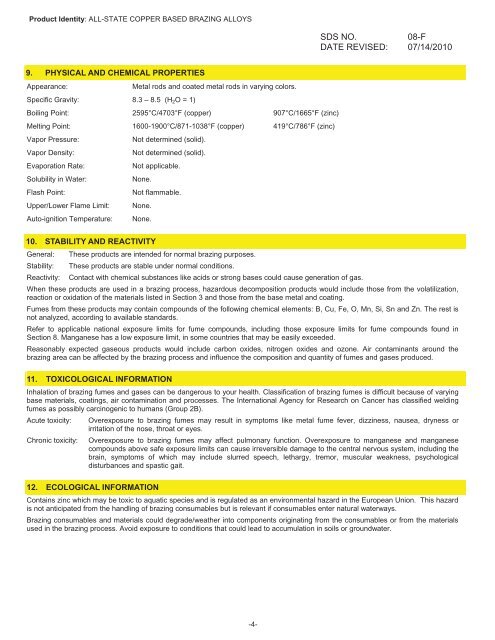Print MSDS - Miller Electric Company Publications
Print MSDS - Miller Electric Company Publications
Print MSDS - Miller Electric Company Publications
Create successful ePaper yourself
Turn your PDF publications into a flip-book with our unique Google optimized e-Paper software.
Product Identity: ALL-STATE COPPER BASED BRAZING ALLOYS<br />
9. PHYSICAL AND CHEMICAL PROPERTIES<br />
Appearance: Metal rods and coated metal rods in varying colors.<br />
Specific Gravity: 8.3 – 8.5 (H2O = 1)<br />
Boiling Point: 2595°C/4703°F (copper) 907°C/1665°F (zinc)<br />
Melting Point: 1600-1900°C/871-1038°F (copper) 419°C/786°F (zinc)<br />
Vapor Pressure: Not determined (solid).<br />
Vapor Density: Not determined (solid).<br />
Evaporation Rate: Not applicable.<br />
Solubility in Water: None.<br />
Flash Point: Not flammable.<br />
Upper/Lower Flame Limit: None.<br />
Auto-ignition Temperature: None.<br />
-4-<br />
SDS NO. 08-F<br />
DATE REVISED: 07/14/2010<br />
10. STABILITY AND REACTIVITY<br />
General: These products are intended for normal brazing purposes.<br />
Stability: These products are stable under normal conditions.<br />
Reactivity: Contact with chemical substances like acids or strong bases could cause generation of gas.<br />
When these products are used in a brazing process, hazardous decomposition products would include those from the volatilization,<br />
reaction or oxidation of the materials listed in Section 3 and those from the base metal and coating.<br />
Fumes from these products may contain compounds of the following chemical elements: B, Cu, Fe, O, Mn, Si, Sn and Zn. The rest is<br />
not analyzed, according to available standards.<br />
Refer to applicable national exposure limits for fume compounds, including those exposure limits for fume compounds found in<br />
Section 8. Manganese has a low exposure limit, in some countries that may be easily exceeded.<br />
Reasonably expected gaseous products would include carbon oxides, nitrogen oxides and ozone. Air contaminants around the<br />
brazing area can be affected by the brazing process and influence the composition and quantity of fumes and gases produced.<br />
11. TOXICOLOGICAL INFORMATION<br />
Inhalation of brazing fumes and gases can be dangerous to your health. Classification of brazing fumes is difficult because of varying<br />
base materials, coatings, air contamination and processes. The International Agency for Research on Cancer has classified welding<br />
fumes as possibly carcinogenic to humans (Group 2B).<br />
Acute toxicity: Overexposure to brazing fumes may result in symptoms like metal fume fever, dizziness, nausea, dryness or<br />
irritation of the nose, throat or eyes.<br />
Chronic toxicity: Overexposure to brazing fumes may affect pulmonary function. Overexposure to manganese and manganese<br />
compounds above safe exposure limits can cause irreversible damage to the central nervous system, including the<br />
brain, symptoms of which may include slurred speech, lethargy, tremor, muscular weakness, psychological<br />
disturbances and spastic gait.<br />
12. ECOLOGICAL INFORMATION<br />
Contains zinc which may be toxic to aquatic species and is regulated as an environmental hazard in the European Union. This hazard<br />
is not anticipated from the handling of brazing consumables but is relevant if consumables enter natural waterways.<br />
Brazing consumables and materials could degrade/weather into components originating from the consumables or from the materials<br />
used in the brazing process. Avoid exposure to conditions that could lead to accumulation in soils or groundwater.



